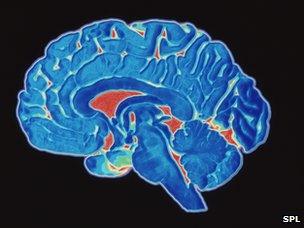Myths about our minds
- Published
The human brain is the most complex entity in the known universe and despite the best endeavours of scientists, there are still many mysteries about the 1.5kg (3.3lb) crinkled blob between our ears.
Here are just a few of the many myths about our brains and how they work.
PEOPLE USE ONLY 10% OF THEIR BRAINS

The brain scan put pay to the myth we only use one 10th of our brains
I remember first hearing that we used just a 10th of our brains in the 1970s when I was at school.
And how amazing, I thought, that there might be a way to unlock that whopping 90% of unused brain capacity.
What would not be possible with all of my grey matter in action?
It was nonsense back then, and technological leaps in brain scanning has now proved this for all to see.
"Functional imaging has shown us that there are very few parts of the brain that can't be activated by something," says Prof Sophie Scott of the Institute of Cognitive Science at University College, London.
Even doing something simple, such as clenching your fist, uses much more than 10% of the brain. A functional brain scan reveals that a vast number of brain cells spring into action as they plan and initiate the contraction of muscles in your fingers and palm.
THE LEFT BRAIN VERSUS THE RIGHT BRAIN
Anatomically, the brain is divided into two halves - the left hemisphere and the right one. There is some division of labour between them.
"There are really big differences between the left and the right sides of the brain," says Prof Scott.
"But that's never what people actually mean when you hear the terms used out in a wider discourse. That's very frustrating."
From some self-improvement books and business management courses, you might think the two hemispheres are in effect two separate entities.
The left is portrayed as the seat of logic and rationality. The right is described as the font of intuition and creativity. Therefore, if you are a logical person, you use your left brain more. If you are more touchy-feely and artistic, you are right-brained.
According to the myth, we would all be more successful and fulfilled people if we learnt to tap the full potential of both hemispheres.
Prof Scott says individuals do differ in the way they think through problems and reflect on the world, but this has nothing to do with different balances of power between their hemispheres.
"Some people have really good visual imagery. Some people have good auditory imagery. There is lots of variation out there in how we take information in and process it.
"But boiling it down into a left brain 'logical' and right brain 'creative' approach does not follow from what we see in how the brain operates. Also it also suggests you could be using one hemisphere more than the other and that's not really how it works."
The two sides communicate with each other and work together via a complex wodge of neural cabling known as the corpus callosum. The two sides of the brains are complementary and work in concert.
A FULL MOON INCREASES ABNORMAL BEHAVIOUR

A full moon has long been associated with things that go bump in the night
In folklore, a full moon is associated with insanity - hence the word lunacy - werewolves and all manner of unpleasant happenings.
However, when psychologists and statisticians have looked into the matter, a lunar influence on the human brain and behaviour remains elusive.
Overwhelmingly they have failed to discover a correlation between the timing of a full moon and events such as assaults, arrests, suicides, calls to crisis centres, psychiatric admissions, poisonings and vehicle accidents.
Eric Chudler, who has compiled a long list of the research says: "Most of the data - and there have been many studies - find that there is not an association between the phase of the moon and any of those abnormal behaviours."
Many believers of the full moon myth work in law enforcement and health professions.
Police officers and hospital staff frequently witness horrific and upsetting events.
Mr Chudler suggests that when these traumatic things happen, workers are much more likely to notice a full moon shining in the sky than they are to register more modest half or quarter moons.
Consequently, they only make a connection with accidents or crimes when the moon is at its most obvious and symbolically significant.
LISTENING TO MOZART MAKES YOU MORE INTELLIGENT
Classical composer Amadeus Mozart is at the heart of an idea which blossomed in the 1990s.

Mozart's music was credited with special powers
People started to believe that playing the music of Mozart to young children would enhance their brain development and make them more intelligent.
And unlike the other myths this one had a notion of truth about it.
The neuro-nonsensical notion became known as the Mozart effect. And the IQ claims started with a science paper in the journal Nature in 1993.
The research described an experiment in which Californian university students did a series of spatial reasoning tasks.
The students who heard a Mozart piano piece before the testing began did a bit better than those who listened to relaxation tape music or silence.
But the sonata-charged enhancement disappeared after about 15 minutes.
Within a couple of years, the media had snowballed this interesting observation into the concept that playing Mozart to young children made them brainier.
Companies marketed and sold CDs of the musical genius' works for this purpose. In the USA in 1998, the state of Georgia issued mothers of newborn babies with their own Mozart discs.
Some people theorised that the musical structures of Mozart's compositions had a special biological influence on the brain's wiring.
In subsequent studies, the truth turned out to be more mundane.
It emerged that any piece of stimulating music just before a series of brain teasers makes you more alert and enthusiastic so you perform a little better.
Mind Myths presented by Claudia Hammond will be on Radio 4 on Tuesday, 8 November at 21:00 GMT and repeated at 15.30 GMT on Wednesday, 9 November.